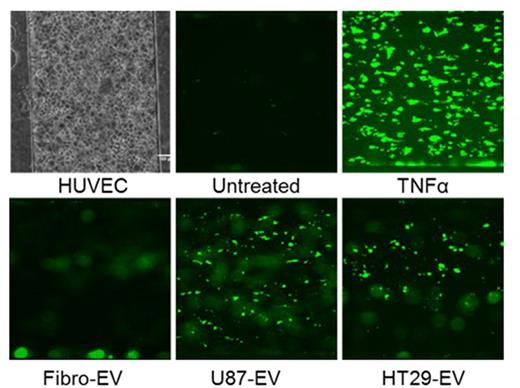Abstract
Introduction:
The risk of thrombosis is markedly increased in patients with cancer, and cancer-associated thrombosis (CAT) is associated with significant morbidity and mortality. It is likely that several mechanisms contribute to the development of CAT, although these may vary among different types of cancers and under different conditions. While genetically-engineered mice may be valuable models for studying thrombosis, an in-vitro model of human vasculature would enable study of CAT mechanisms more rapidly and with less expense; however, at this point such models are not well-developed. Extracellular vesicles (EV) are cell-derived particles, most of which range from <100 nM to 500 nM in diameter. These may arise from cancer cells, stromal cells, or vascular cells, including platelets, endothelial cells and leukocytes, and circulate at elevated concentrations in patients with cancer. EV may induce thrombosis through a variety of mechanisms, including expression of tissue factor, contact activation, and potentially other mechanisms including transfer of RNA or proteins to vascular cells, enhancing their prothrombotic activity.
Methods:
To develop a system for evaluating the prothrombotic potential of EV on a microscale, we used the Cellix microfludic system, with which we can assess cellular adhesion to the wall of a glass capillary tube through which fluid is driven by a peristaltic pump. In these experiments human umbilical vein endothelial cells (HUVEC) were cultured in fibronectin-coated glass capillary tubes, forming an intact monolayer (Figure, top left panel). After washing non-adherent endothelial cells from the vessel, the endothelial cell-lined vessels were exposed to EV derived from cancer cell lines (U87 glioblastoma or HT29 colorectal carcinoma), or primary human fibroblasts, for four hours prior to flowing of normal human whole blood, to which calcein-AM had been added to label platelets, through the vessel at a shear rate of 67 dynes/cm2. TNFα was used as a positive control to induce an adhesive endothelial cell phenotype. In some experiments, EV were added directly to whole blood, or both preincubated with endothelial cells and added to whole blood before perfusion through the system.
Results:
As expected (see Figure), we observed that preincubation of TNFα with HUVEC-lined vessels significantly increased platelet adhesion to the endothelial cell monolayer (~100 arbitrary fluorescence units, AFU). In addition, either preincubation of endothelial cells with U87 or HT29-derived exosomes (Figure), or addition of cancer cell-derived exosomes to whole blood also led to markedly-increased rates of platelet adhesion (50-80 AFU) to the endothelial monolayer, and in some cases caused complete occlusion of the vessel and cessation of flow (e.g. in vitro thrombus formation). Normal fibroblast-derived EV also stimulated platelet adhesion but to a much lower extent than cancer cell-derived EV (~20 AFU). Addition of cancer cell-derived EV to both the microfluidics vessel and whole blood almost universally caused vessel occlusion. In further studies, we also found that whole blood from Lewis lung carcinoma-bearing mice was more prothrombotic in this system than that from non-tumor-bearing littermates (~60% higher), and that the absence of high molecular weight kininogen (studied using blood from tumor bearing and non-tumor-bearing kininogen deficient mice) partially protected again vascular occlusion in this model.
Conclusion:
These studies suggest that cancer cell-derived EV are more prothrombotic than EV derived from non-transformed cells in this model vessel lined by human endothelial cells. Additional work is needed to further define the underlying mechanism by which this occurs, but involvement of the contact activation system is likely, particularly based on preliminary results using blood from tumor-bearing kininogen deficient mice. This microfluidics system will be of significant value in future translational and mechanistic studies focused on mechanisms of CAT.
Khorana: Janssen Scientific Affairs, LLC: Consultancy, Honoraria, Research Funding; Leo: Consultancy, Honoraria, Research Funding; Sanofi: Consultancy, Honoraria; Amgen: Consultancy, Honoraria, Research Funding; Bayer: Consultancy, Honoraria; Halozyme: Consultancy, Honoraria; Pfizer: Consultancy, Honoraria; Roche: Consultancy, Honoraria.
Author notes
Asterisk with author names denotes non-ASH members.


This feature is available to Subscribers Only
Sign In or Create an Account Close Modal